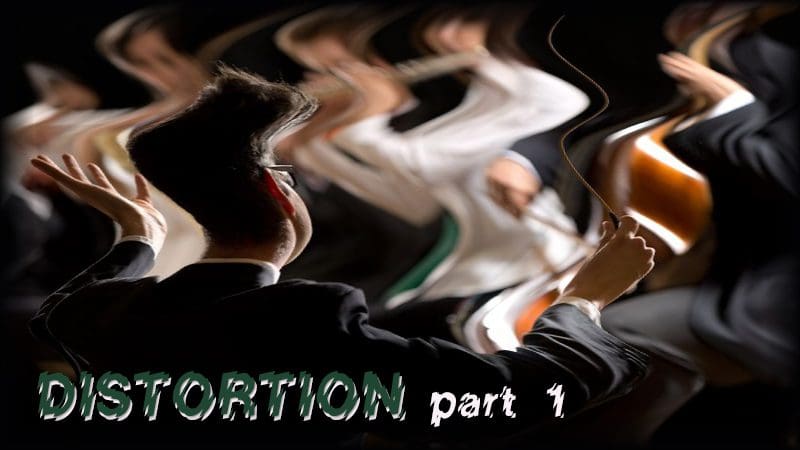 When we talk about any signal, be it audio, video or data, there is an accompanied reality for alterations and errors made to that signal as it passes through different electronic components, conductors or magnetic fields. While we get concerned when we hear that a component introduces distortion or when we read distortion specifications, distortion is part of nature and is simply unavoidable. Until any distortion reaches a significant level in an analog signal, it can’t be heard or seen.
When we talk about any signal, be it audio, video or data, there is an accompanied reality for alterations and errors made to that signal as it passes through different electronic components, conductors or magnetic fields. While we get concerned when we hear that a component introduces distortion or when we read distortion specifications, distortion is part of nature and is simply unavoidable. Until any distortion reaches a significant level in an analog signal, it can’t be heard or seen.
Starting With A Foundation in Audio Distortion
With that in mind, let’s create a foundation for observing and understanding the properties of an audio signal in the electrical and frequency domains. This information will serve as the foundation for understanding distortion in part two of this article.
Any signal, be it Direct Current (DC) or Alternating Current (AC), can be analyzed in two ways – in its time domain or frequency domain. Understanding the difference between these two observation domains will dramatically simplify the life of anyone involved in the mobile electronics industry.
When we observe a signal in the time domain, we are looking at the amplitude of the signal relative to time. Normally, we would use a voltmeter or oscilloscope to look at signals in the time domain. When we consider a signal in the frequency domain, we are comparing the amplitude (or strength) of individual frequencies, or groups of frequencies within the signal. We use an RTA (real time analyzer) on a computer or handheld/benchtop devices to look at the frequency domain.
Direct Current
When analyzing the amplitude of an electrical signal, we compare the signal to a reference; in 99% of applications, the reference is known as ground. For a DC signal, the voltage level remains constant with respect to the ground reference and to time. Even if there are fluctuations, it is still a DC signal.
If you were to chart the frequency content of a DC signal, you would see it is all at 0 hertz (Hz). The amplitude does not change relative to time.
Let’s consider the DC battery voltage of your car or truck. It is a relatively constant value. Regarding amplitude versus time, it sits around a 12.7-12.9 volts on a fully charged battery with the vehicle off. When the vehicle is running and the alternator is charging, this voltage increases to around 13.5 to 14.3 volts. This increase is caused because the alternator is feeding current back into the battery to charge it. If the voltage produced by the alternator was not higher than the resting voltage of the battery, current would not flow and the battery would not be recharged.
Alternating Current
AC Signal – Time
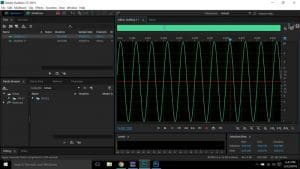 If we look at an AC signal, such as a 1 kHz tone that we would use to set the sensitivity controls on an amplifier, we see something very different. In the case of a pure test tone like this, the waveform has a sinusoidal shape, called a sine wave. If we look at a sine wave on an oscilloscope, we see a smoothly rolling waveform that extends just as much above our reference voltage as it does below.
If we look at an AC signal, such as a 1 kHz tone that we would use to set the sensitivity controls on an amplifier, we see something very different. In the case of a pure test tone like this, the waveform has a sinusoidal shape, called a sine wave. If we look at a sine wave on an oscilloscope, we see a smoothly rolling waveform that extends just as much above our reference voltage as it does below.
AC Signal – Frequency
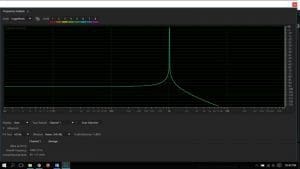 It is now wise to look at this same signal from the perspective of the frequency domain. The frequency domain graph will, if there is no distortion, show a single frequency. In consideration of an audio signal, the amplitude (or height) of that frequency measurement depends on how loud that single frequency is relative to the limits of our recording technology or measurement device.
It is now wise to look at this same signal from the perspective of the frequency domain. The frequency domain graph will, if there is no distortion, show a single frequency. In consideration of an audio signal, the amplitude (or height) of that frequency measurement depends on how loud that single frequency is relative to the limits of our recording technology or measurement device.
Audio
When we listen to someone speak or play a musical instrument, we hear many different frequencies at the same time. The human brain is capable of decoding the different frequencies and amplitudes. Based on our experiences, and the differences in frequency and time response between one ear and the other, we can determine what we are hearing, and the location of the sound relative to ourselves.
Analyzing the time domain content of an audio signal is relatively easy. We would use an oscilloscope to observe an audio waveform. The scope will show us the signal voltage versus time. This is a powerful tool in terms of understanding signal transmission between audio components.
A Piano Note
Middle C – Time
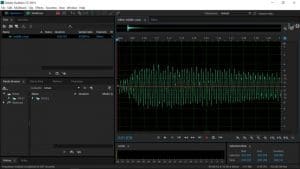 Let’s look at the amplitude and frequency content of a sound most of us know well. The following graph is the first 0.25 seconds of a recording of a piano’s middle C (C4) note in the time domain. This represents the initial hit of the hammer onto the string. If you look at the smaller graph above the larger one, you will see the note extends out much further than this initial .25 second segment.
Let’s look at the amplitude and frequency content of a sound most of us know well. The following graph is the first 0.25 seconds of a recording of a piano’s middle C (C4) note in the time domain. This represents the initial hit of the hammer onto the string. If you look at the smaller graph above the larger one, you will see the note extends out much further than this initial .25 second segment.
Middle C – Frequency
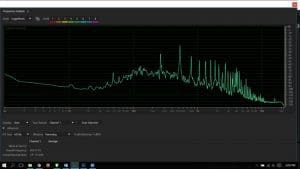 We know that the fundamental frequency of this note is 261.6 Hz, but if you look at the frequency domain graphs, we can see that several additional and important frequencies are present. These frequencies are called harmonics. They are multiples of the fundamental frequency, and the amplitude of these harmonics is what makes a small upright piano sound different from a grand piano, and from a harp or a guitar. All of these instruments have the same fundamental middle C frequency of 261.6 Hz; their harmonic content makes them sound different. In the case of this piano note recording, we can see there is a large spike at 523 Hz, then increasingly smaller spikes at 790 Hz, 1055 Hz, 1320 Hz and so on.
We know that the fundamental frequency of this note is 261.6 Hz, but if you look at the frequency domain graphs, we can see that several additional and important frequencies are present. These frequencies are called harmonics. They are multiples of the fundamental frequency, and the amplitude of these harmonics is what makes a small upright piano sound different from a grand piano, and from a harp or a guitar. All of these instruments have the same fundamental middle C frequency of 261.6 Hz; their harmonic content makes them sound different. In the case of this piano note recording, we can see there is a large spike at 523 Hz, then increasingly smaller spikes at 790 Hz, 1055 Hz, 1320 Hz and so on.
Sine vs Square Waveforms
Every audio waveform is made up of a complex combination of fundamental and harmonic frequencies. The most basic, as we mentioned, is a pure sine wave. A sine wave has only a single frequency. At the other end of the spectrum is a square wave. A square wave is made up of a fundamental frequency, then an infinite combination of odd-ordered harmonics at exponentially decreasing levels. Keep this in mind, since it will become important later as we begin to discuss distortion.
Noise Signals
Noise is a term that describes a collection of random sounds or sine waves. However, we can group a large collection of these sine waves together and use them as a tool for testing audio systems. When we want to measure the frequency response of a component like a signal processor or an amplifier, we can feed a white noise signal through the device and observe the changes it makes to the amplitudes of different frequency ranges.
White Noise – Time
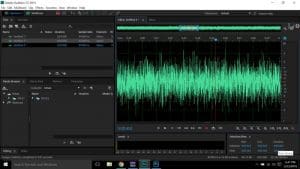 You may be asking, what exactly is white noise? It is a group of sine waves at different frequencies, arranged so the energy in each octave band is equal to the bands on either side. We can view white noise from a time domain as shown here.
You may be asking, what exactly is white noise? It is a group of sine waves at different frequencies, arranged so the energy in each octave band is equal to the bands on either side. We can view white noise from a time domain as shown here.
White Noise – Frequency
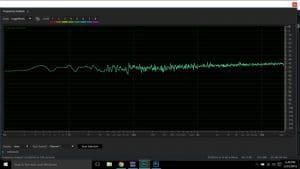 We can also view it from the frequency domain, as displayed in this image.
We can also view it from the frequency domain, as displayed in this image.
Variations In Response
The slight undulations in the frequency graph are present because it takes a long time for all different frequencies to be played and produce a ruler-flat graph. On a 1/3-octave scope, the graph would be essentially flat.
Foundation For Time And Frequency Domains
There we have our basic foundation for understanding the observation of signals in the time domain and the frequency domain. We have also had our first glimpse into how harmonic content affects what we hear. Understanding these concepts is important for anyone who works with audio equipment, and even more important to the people who install and tune that equipment. Your local mobile electronics specialist should be very comfortable with these concepts, and can use them to maximize the performance of your mobile entertainment system.
If you’ve made it this far and want to learn even more about audio distortion, click here for Part 2 of this article!
This article is written and produced by the team at www.BestCarAudio.com. Reproduction or use of any kind is prohibited without the express written permission of 1sixty8 media.
Leave a Reply